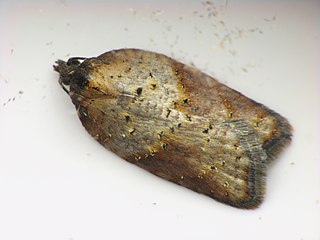
An exedra is a semicircular architectural recess or platform, sometimes crowned by a semi-dome, and either set into a building's façade or free-standing. The original Greek sense was applied to a room that opened onto a stoa, ringed with curved high-backed stone benches, a suitable place for conversation. An exedra may also be expressed by a curved break in a colonnade, perhaps with a semicircular seat.

The Tortricidae are a family of moths, commonly known as tortrix moths or leafroller moths, in the order Lepidoptera. This large family has over 11,000 species described, and is the sole member of the superfamily Tortricoidea, although the genus Heliocosma is sometimes placed within this superfamily. Many of these are economically important pests. Olethreutidae is a junior synonym. The typical resting posture is with the wings folded back, producing a rather rounded profile.

The Imperial Fora are a series of monumental fora, constructed in Rome over a period of one and a half centuries, between 46 BC and 113 AD. The fora were the center of the Roman Republic and of the Roman Empire.

Chlidanotinae is a subfamily of moths in the family Tortricidae.
Sycacantha is a genus of moths belonging to the subfamily Olethreutinae of the family Tortricidae.
Paraphyas is a genus of moths belonging to the subfamily Tortricinae of the family Tortricidae. It contains only one species, Paraphyas callixena, which is found in Australia, where it has been recorded from Western Australia and Tasmania. The habitat consists of wet sclerophyll forests.

The Tortricini are a tribe of tortrix moths.

The Olethreutini are a tribe of tortrix moths.
Bucculatrix exedra is a species of moth of the family Bucculatricidae. It is found in Japan and India. It was first described in 1915 by Edward Meyrick.

Dichelopa panoplana is a moth of the family Tortricidae. It is known from Australia, where it widespread in semiarid areas from southern Queensland to South Australia.
Sycacantha diakonoffi is a moth of the family Tortricidae. It is found in Thailand and Vietnam.
Sycacantha pararufata is a moth of the family Tortricidae. It is found in Vietnam.
Sycacantha ngoclinhana is a moth of the family Tortricidae. It is found in Vietnam.
Sycacantha montana is a moth of the family Tortricidae. It is found in Vietnam.
Capnoptycha ipnitis is a species of moth of the family Tortricidae. It is found in Australia, where it has been recorded from Queensland and New South Wales.
Sycacantha sphaerocosmana is a species of moth of the family Tortricidae. It is found in Australia, where it has been recorded from Queensland.
Diakonoffiana tricolorana is a species of moth of the family Tortricidae. It is found in New Caledonia, New Guinea and Australia, where it has been recorded from New South Wales and Queensland.
Sycacantha nereidopa is a species of moth of the family Tortricidae. It is found in the Democratic Republic of the Congo, Kenya and Uganda.
Sycacantha escharota is a species of moth of the family Tortricidae first described by Edward Meyrick in 1910. It is found on the Indonesian islands of Sulawesi and Seram. The habitat consists of bamboo and secondary forests.






